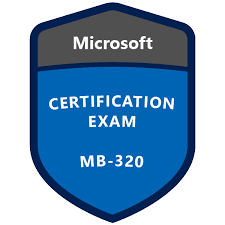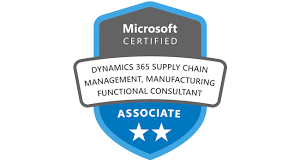Audience
A Dynamics 365 for Finance and Operations Functional Consultant is responsible for performing discovery, capturing requirements, engaging subject matter experts and stakeholders, translating requirements, and configuring the solution and applications. The Functional Consultant implements a solution using out of the box capabilities, codeless extensibility, application and service integrations.
Skills Gained
After completing this course, students will be able to:
• Set up and configure financial management
• Implement accounts receivable, credit, collections, and revenue recognition
• Implement and manage accounts payable and expenses
• Manage budgeting
• Manage fixed assets
Course outline
Module 1: Overview of Dynamics 365 Finance
This module will discuss the core components of Finance and look at the modules involved.
Lessons
• Introduction
• Lesson 1: Overview of Dynamics 365 Finance Features and capabilities
• Lesson 2: Core components of Dynamics 365 Finance
• Lesson 3: Overview of financial management modules in Dynamics 365 Finance
• Lesson 4: Benefits of Dynamics 365 Finance
Module 2: Set up and configure financial management
In this module, we will discuss how to create a new legal entity (company) and setup and configure financial management for it. This module includes general ledger.
Lessons
• Introduction
• Lesson 1: Create and configure new legal entity
• Lesson 2: Define and configure the chart of accounts
• Lesson 3: Configure ledgers and currencies
• Lesson 4: Implement and manage journals
• Lesson 5: Implement and manage cash and bank
• Lesson 6: Implement cost accounting and cost management
• Lesson 7: Perform periodic processes
• Lesson 8: Configure, collect, and report taxes
Lab
Lab : Exercise 1: Configure a new legal entity
Lab : Exercise 2: Create a chart of accounts and main accounts
Lab : Exercise 3: Create Advanced Rule Structures
Lab : Exercise 4: Create a fiscal calendar, years and periods
Lab : Exercise 5: Import exchange rates by using a provider
Lab : Exercise 6: Create and use Voucher templates
Lab : Exercise 7: Configure and test Accrual schemes
Lab : Exercise 8: Configure and test ledger allocation rules
Lab : Exercise 9: Set up and use Intercompany accounting
Lab : Exercise 10: Create bank transaction types and bank transaction groups
Lab : Exercise 11: Create a bank group and bank account
Lab : Exercise 12: Make deposits and perform payment reversals
Lab : Exercise 13: Use Bank management workspaces
Lab : Exercise 14: Create Cost accounting by using a wizard
Lab : Exercise 15: Perform year end close
Lab : Exercise 16: Configure Indirect sales tax
Module 3: Implement and manage shared configuration for A/P and A/R
Dynamics 365 Finance offers extensive functionality for setting up different payment options which are shared between accounts payable and receivable modules.
Lessons
• Introduction
• Lesson 1: Configure Terms of payment
• Lesson 2: Configure payment days, and payment schedules
• Lesson 3: Configure Cash discounts
• Lesson 4: Configure Payment calendar
• Lesson 5: Configure Payment fees
Labs
Lab : Exercise 1: Configure Terms of payment
Lab : Exercise 2: Configure Payment Schedule
Lab : Exercise 3: Configure cash discounts
Lab : Exercise 4: Create a payment calendar
Lab : Exercise 5: Configure Payment fees
Module 4: Implement and manage accounts payable
This topic explains the basic setup of accounts payable and the vendor setup for efficient management of vendors and vendor transactions in Dynamics 365 Finance.
Lessons
• Introduction
• Lesson 1: Create and maintain Accounts payable method of payments
• Lesson 2: Create and maintain Vendor groups and vendors
• Lesson 3: Create and configure vendor posting profile
• Lesson 4: Configure invoice validation policies
• Lesson 5: Process orders, invoices, and payments
• Lesson 6: Enable and test vendor collaboration portal for a vendor
• Lesson 7: Configure accounts payable charges
• Lesson 8: Configure and use Positive pay
Labs
Lab : Exercise 1: Configure Method of Payment
Lab : Exercise 2: Create Vendor group and vendor
Lab : Exercise 3: Create and configure vendor posting profile
Lab : Exercise 4: Record vendor invoice and match against received quantity
Lab : Exercise 5: Use the vendor invoice matching policy
Lab : Exercise 6: Record invoice by using Invoice register, approval and Invoice journals
Lab : Exercise 7: Process Vendor payment by using a Payment journal
Lab : Exercise 8: Configure vendor collaboration
Lab : Exercise 9: Manage charges
Module 5: Implement and manage expense management
You can use the Dynamics 365 Finance and Operations apps expense management to create an integrated workflow where you can store payment method information, import credit card transactions, and track the money that employees spend when they incur expenses for your business. You can also define expense policies and automate the reimbursement of travel expenses. Expense report entry has been redesigned to simplify the experience and decrease the time that is required to complete expense reports. You can turn on this functionality in Feature management. You can add a new setup page to configure the visibility of expense fields, and specify what data is required, optional, or not available when expense reports are entered. When this functionality is turned on, a new expense workspace is available. This workspace replaces the previous expense workspace and is the landing page for the improved entry experience. Travel and expense management has a strong value proposition for organizations with discretionary spending. Travel and entertainment expenses are a significant part of a company’s controllable expense. To help curb these costs, expense management provides a mechanism to define and apply expense policies, in addition to flagging and reporting on abusers of the policies. Additionally, automating the entry and reimbursement of travel and entertainment expenses reduces processing costs versus manual entry. Expense management has tight integration with other modules such as Accounts payable, General ledger, Procurement, and sourcing and Project management and accounting.
Lessons
• Introduction
• Lesson 1: Configure and use expense management
Labs
Lab : Exercise 1: Create an Expense Category
Lab : Exercise 2: Create an Expense Policy
Lab : Exercise 3: Create an Audit Policy
Lab : Exercise 4: Create and Submit an Expense Report
you have learned some of benefits and overall features and functionality of Expense management.
Module 6: Implement and manage accounts receivable and credit and collections
You need to configure the Accounts receivable module to be able to perform A/R functionality. You could then create customer invoices, post packing slips, use free text invoices that are not related to sales orders, and receive payments by using several different payment types such as cash, checks, credit cards, and electronic payments from your customers. Managing prospects and customers properly helps businesses to fulfil some of their requirements, such as customers’ satisfaction. At the same time, proper management avoids loss by checking many factors such as the credit limit and blocking the order being processed if it violates the policies of the company. Salespersons are the key for company’s revenue, and their commissions should be taken care of upon completion of the sales cycle.
Lessons
• Introduction
• Lesson 1: Configure Method of Payment
• Lesson 2: Create and maintain Customer groups and customers
• Lesson 3: Create and configure customer posting profile
• Lesson 4: Process orders, invoices, and payments
• Lesson 5: Configure Accounts receivable charges
• Lesson 6: Manage credit and collections
• Lesson 7: Configure revenue recognition
Labs
Lab : Exercise 1: Configure Method of Payment
Lab : Exercise 2: Create a new customer group and customer
Lab : Exercise 3: Configure and maintain customers
Lab : Exercise 4: Create and configure customer posting profile
Lab : Exercise 5: Create and process free text invoices
Lab : Exercise 6: Process invoice and settle it against a payment
Lab : Exercise 7: Set up charge codes for Accounts receivable
Lab : Exercise 8: Configure Credit and collections
Lab : Exercise 9: Perform Write-Offs
Lab : Exercise 10: Process credit and collections
Module 7: Configure and manage budgeting
Every organization, whether it is private or public, sets financial and operational goals by creating budgets. When the budget is established, management monitors the activities within the budget framework.
Lessons
• Introduction
• Lesson 1: Configure and use basic budgeting
• Lesson 2: Configure and use budget controls
• Lesson 3: Create and configure registry entries
• Lesson 4: Configure and use budget planning
Labs
Lab : Exercise 1: Configure Basic budgeting components
Lab : Exercise 2: Configure Budget control components
Lab : Exercise 3: Use Budget register entries
Lab : Exercise 4: Configure Budget planning, create and use a planning process
Module 8: Configure and manage fixed assets
The way in which fixed assets are handled must correspond to both international accounting standards and the accounting legislation in each country/region. Requirements might include rules for recording acquisition and disposal transactions, depreciation, lifetimes, and write-ups and write-downs of fixed assets. The Fixed assets functionality incorporates many of these standards and rules.
Lessons
• Introduction
• Lesson 1: Configure Fixed assets components
• Lesson 2: Manage Fixed assets
• Lesson 3: Fixed asset acquisition, depreciation and disposal
• Lesson 4: Fixed asset integration
Labs
Lab : Exercise 1: Configure fixed assets components
Lab : Exercise 2: Set up and create depreciation profiles
Lab : Exercise 3: Acquiring an Asset Using the Fixed Assets Journal
Lab : Exercise 4: Depreciating and disposing an asset
Schedule
Click on the following link to see the Current Course Schedule
Our minimum class-size is 3 for this course.
If there are no scheduled dates for this course, it can be customized to suit the time and skill needs of clients and it can be held online, at a rented location or at your premises.
Click on the following link below to arrange for a custom course: Enquire about a course date








Reviews
There are no reviews yet.